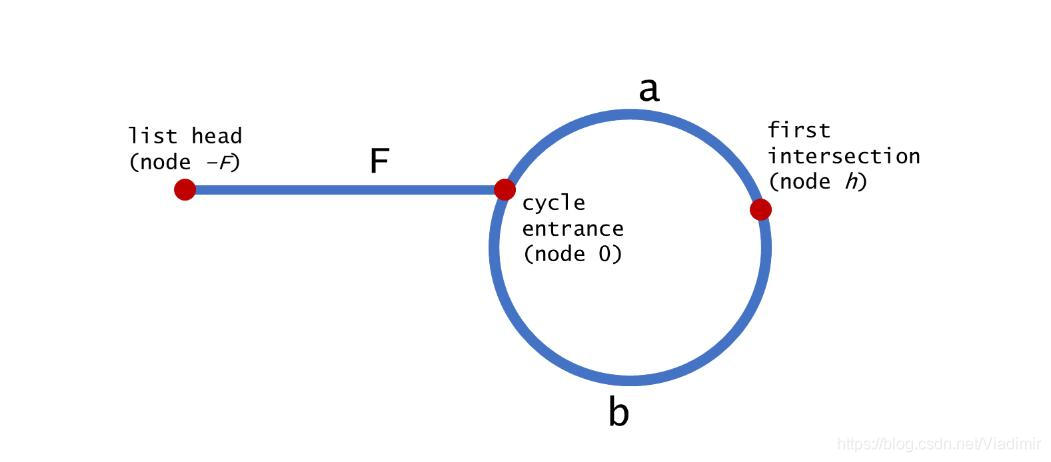题目描述如下:
给定一个链表,返回链表开始入环的第一个节点。 如果链表无环,则返回 null。
为了表示给定链表中的环,我们使用整数 pos 来表示链表尾连接到链表中的位置(索引从 0 开始)。 如果 pos 是 -1,则在该链表中没有环。
说明:不允许修改给定的链表。
示例 1:
输入:head = [3,2,0,-4], pos = 1
输出:tail connects to node index 1
解释:链表中有一个环,其尾部连接到第二个节点。
示例 2:
输入:head = [1,2], pos = 0
输出:tail connects to node index 0
解释:链表中有一个环,其尾部连接到第一个节点。
示例 3:
输入:head = [1], pos = -1
输出:no cycle
解释:链表中没有环。
进阶:
你是否可以不用额外空间解决此题?
这道题目如果可以修改给定链表的话是非常简单的,因为可以改变链表里节点值的类型,然后遍历链表,如果遍历到的节点的值类型是修改后的类型,那么入口节点就是这个节点。(实在写不出来的可以用这种方法,空间消耗击败了百分百的提交)
Python3代码如下:
# Definition for singly-linked list.
# class ListNode:
# def __init__(self, x):
# self.val = x
# self.next = None
class Solution:
def detectCycle(self, head: ListNode) -> ListNode:
temp = head
i = 1
while temp!=None:
if isinstance(temp.val,dict)==True:
return temp
elif isinstance(temp.val,int)==True:
temp.val = {i:temp.val}
temp = temp.next
i = i + 1正规的、符合题意的进阶做法,是官方给出的一种叫Floyd 的算法。
Floyd 算法是分两个阶段来做的,第一个阶段利用快慢指针法找出链表是否有环(这道题的快慢指针法的详解,大家可以参考我的另一篇博客:https://blog.youkuaiyun.com/Viadimir/article/details/102633859);第二阶段的思路是:给定阶段 1 找到的相遇点,阶段 2 将找到环的入口。首先我们初始化额外的两个指针: ptr1 、ptr2,ptr1指向链表的头, ptr2 指向相遇点。然后,我们每次将它们往前移动一步,直到它们相遇,它们相遇的点就是环的入口,返回这个节点。
关于这两个指针为什么一定会在入口处相遇,官方解释如下:


Python3代码如下:
class Solution(object):
def getIntersect(self, head):
tortoise = head
hare = head
# A fast pointer will either loop around a cycle and meet the slow
# pointer or reach the `null` at the end of a non-cyclic list.
while hare is not None and hare.next is not None:
tortoise = tortoise.next
hare = hare.next.next
if tortoise == hare:
return tortoise
return None
def detectCycle(self, head):
if head is None:
return None
# If there is a cycle, the fast/slow pointers will intersect at some
# node. Otherwise, there is no cycle, so we cannot find an e***ance to
# a cycle.
intersect = self.getIntersect(head)
if intersect is None:
return None
# To find the e***ance to the cycle, we have two pointers traverse at
# the same speed -- one from the front of the list, and the other from
# the point of intersection.
ptr1 = head
ptr2 = intersect
while ptr1 != ptr2:
ptr1 = ptr1.next
ptr2 = ptr2.next
return ptr1
























 983
983

 被折叠的 条评论
为什么被折叠?
被折叠的 条评论
为什么被折叠?








